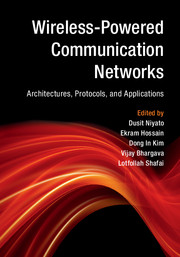Book contents
- Frontmatter
- Contents
- List of contributors
- Preface
- Part I Basics of Wireless Energy Harvesting and Transfer Technology
- Part II Architectures, Protocols, and Performance Analysis
- 4 Cooperative Networks with Wireless Energy Harvesting
- 5 Multiple Antennas and Beamforming for SWIPT Systems
- 6 Backscattering Wireless-Powered Communications
- 7 Dedicated Wireless Energy Harvesting in Cellular Networks: Performance Modeling and Analysis
- 8 Ambient Wireless Energy Harvesting in Small Cell Networks: Performance Modeling and Analysis
- Part III Applications of Wireless Energy Harvesting and Transfer
- Index
- References
6 - Backscattering Wireless-Powered Communications
from Part II - Architectures, Protocols, and Performance Analysis
Published online by Cambridge University Press: 01 December 2016
- Frontmatter
- Contents
- List of contributors
- Preface
- Part I Basics of Wireless Energy Harvesting and Transfer Technology
- Part II Architectures, Protocols, and Performance Analysis
- 4 Cooperative Networks with Wireless Energy Harvesting
- 5 Multiple Antennas and Beamforming for SWIPT Systems
- 6 Backscattering Wireless-Powered Communications
- 7 Dedicated Wireless Energy Harvesting in Cellular Networks: Performance Modeling and Analysis
- 8 Ambient Wireless Energy Harvesting in Small Cell Networks: Performance Modeling and Analysis
- Part III Applications of Wireless Energy Harvesting and Transfer
- Index
- References
Summary
Introduction
The concept of modulating backscatter for communication was first introduced by Stockman in 1948 [1] and promptly received a lot of attention from researchers and developers owing to its potential advantages. Basically, backscatter communication is a technique that allows wireless nodes to communicate without requiring any active radiofrequency (RF) components on the tag [2]. In a conventional backscatter communication system (CBCS), there are two main components, called the wireless tag reader device (WTRD) and the wireless tag device (WTD), as illustrated in Figure 6.1. The WTD in the CBCS is able not only to harvest energy from the received signals, but also to modulate and reflect the signals back to the WTRD. The signal reflection is caused by the intentional mismatch between the antenna and the load impedance at the WTD. Theoretically, when the load impedance is varied, it will generate the complex scatter coefficient which can be used to modulate the reflected signal with information bits. The WTRD then uses the receive antenna to receive reflected signals from the WTD and demodulate these signals to obtain the useful information.
In conventional backscattering communication systems, there are two special features that differ from traditional communication systems. First, in conventional backscattering communication systems, the receivers (i.e., WTRDs) have to be equipped with a power source to transmit RF signals to the transmitter (i.e., WTDs). Second, the transmitters do not need to be equipped with a power source to transmit data because they will reflect signals received by the receivers instead of generating their own signals. The second feature is the most important characteristic and also the main objective for the development of conventional backscattering communication systems. This special communication feature of CBCSs has received a great deal of attention, mainly because of the successful implementation of RFID systems and the potential use in sensor devices that are small in size and have a low power supply.
Typically, backscattering communication systems operate using RF signals and require the WTRD to be able to transmit RF signals to the WTD. However, a new solution, called ambient backscatter communication, which utilizes RF signals from ambient sources, e.g., TV signals [3] and Wi-Fi signals [4], to help the WTRD to obtain data from the WTD without generating RF signals has recently been introduced.
- Type
- Chapter
- Information
- Wireless-Powered Communication NetworksArchitectures, Protocols, and Applications, pp. 217 - 245Publisher: Cambridge University PressPrint publication year: 2016



